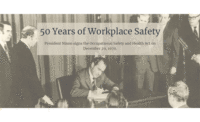New website shows state v. federal OSHA regulations
 A new website that compares and contrasts federal and state OSHA regulations was unveiled yesterday by Public Citizen and the Public Health Law Research (PHLR) program of the Robert Wood Johnson Foundation.
A new website that compares and contrasts federal and state OSHA regulations was unveiled yesterday by Public Citizen and the Public Health Law Research (PHLR) program of the Robert Wood Johnson Foundation.
The site contains the first comprehensive database of all state occupational safety and health regulations and laws intended to protect workers from specific workplace hazards, in the 25 states with federally authorized enforcement agencies.
States take on some hazards not addressed by OSHA
“This database shows that some state OSHA plans have been proactive and issued numerous regulations and laws that are a model for what is possible in other states and at federal OSHA,” said Dr. Sammy Almashat, M.P.H., who helped put the database together. It reveals that most of the 25 states have amended or supplemented one or more federal regulations, and several states have issued regulations or laws protecting workers from hazards such as heat stress, workplace violence, combustible dust and musculoskeletal injuries that have not yet been addressed in a federal OSHA regulation.
“As the first publicly available clearinghouse for state occupational safety and health standards, we hope the database will be a useful resource for workers, employers, researchers and regulatory officials alike, allowing them to more easily identify states with certain standards and compare them with existing federal OSHA rules,” added Keith Wrightson, worker safety advocate with Public Citizen’s Congress Watch division, who compiled the database with Almashat.
Almashat noted that the only regulations and laws that are available on the website are those that are different or have not been adopted identically from federal OSHA. Additionally, only rules related to worker safety are in the database; administrative rules have been excluded.
Big differences
Wrightson said 23 states have developed regulations specific to general industry - meaning they cover all workers. Beyond that, a number of states have passed rules covering specific industries:
- 17 states have construction regulations
- 11 states have regulations related to agriculture
- Five states have regulations to protect oil and gas workers
- two states have regulations to protect maritime workers.
"Only one state has rules concerning mining,” noted Wrightson. “MSHA really has jurisdiction over whole country but in California they have their own rules concerning mining workers, which is quite unique."
Some key findings:
The number of state standards issued by each of the 25 state OSHA plans varies widely. Just four states (California, Michigan, Oregon and Washington) are responsible for the vast majority of all state occupational safety and health standards.
Seven states (Alaska, Connecticut, Hawaii, Minnesota, New York, Tennessee and Vermont) have retained more protective chemical exposure limits developed by federal OSHA in 1989 but rescinded by court order in 1993. Four states (California, Michigan, Oregon and Washington) have developed at least one chemical exposure limit that has never been adopted by federal OSHA.
Three states (California, Minnesota and Washington) have developed standards protecting workers from heat stress.
Three states (New Mexico, New York and Washington) have standards to prevent death and injury from workplace violence.
Two states (California and Utah) have developed standards to prevent explosions from combustible dust.
Two state plans (California and Minnesota) enforce standards or laws addressing safe patient handling requirements to minimize musculoskeletal injuries in health care workers, while California also has a rule addressing ergonomics injuries more generally.
Two states (Michigan and Oregon) have especially informative websites, which compare their state standards with federal OSHA regulations, making it clear where they differ from the federal rules.
The origin of OSHA
The 1970 federal Occupational Safety and Health Act established OSHA to protect workers from occupational safety and health hazards. The act also permitted states to substitute their own rulemaking and enforcement agencies for federal OSHA, as long as the state programs, also known as state OSHA plans, are “at least as effective” as the federal agency. This was intended as a way to allow states to address local needs and unique industries.
About the database
The database was made possible through a $50,000 grant from PHLR. It is published on the program’s LawAtlas website, which was developed as a tool to help policymakers, advocates and researchers understand the various laws on a given topic, how they differ over time and across jurisdictions, and evaluate their impact.
Visit the database.
Looking for a reprint of this article?
From high-res PDFs to custom plaques, order your copy today!







.jpg?t=1721257160)
